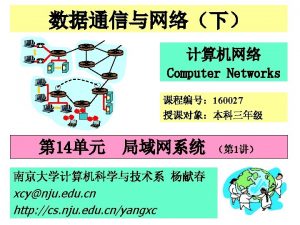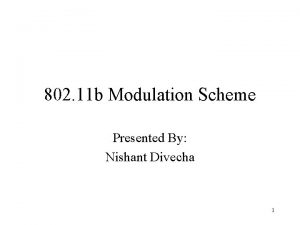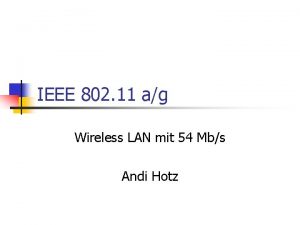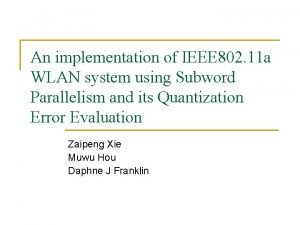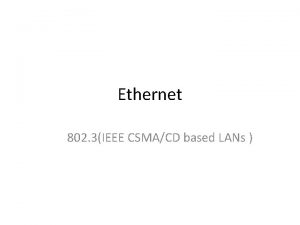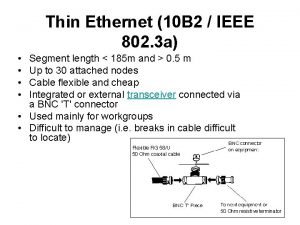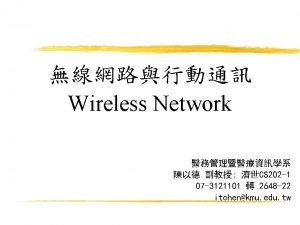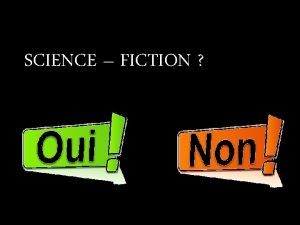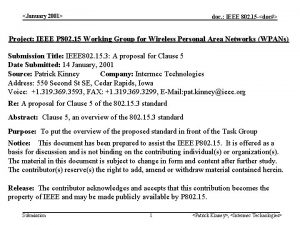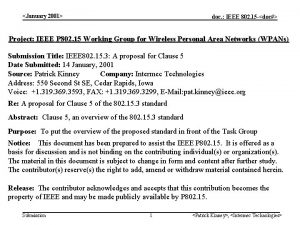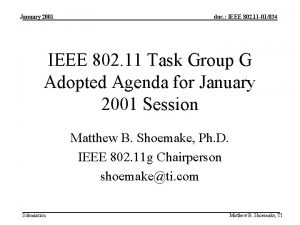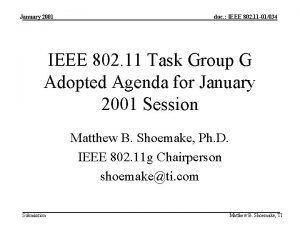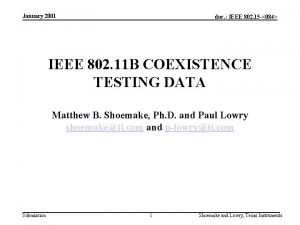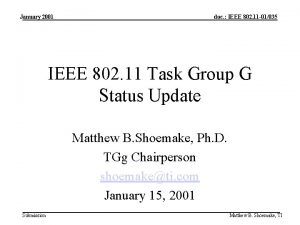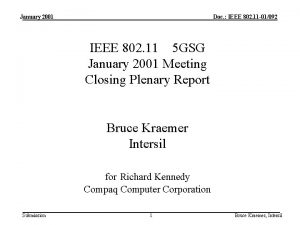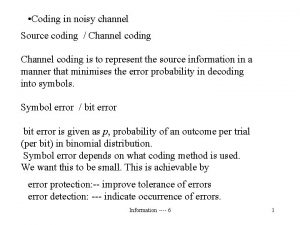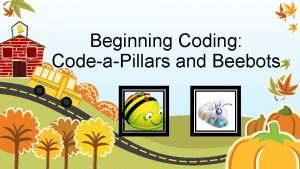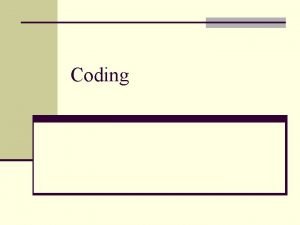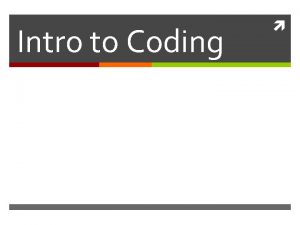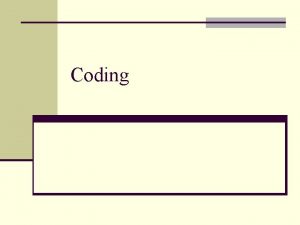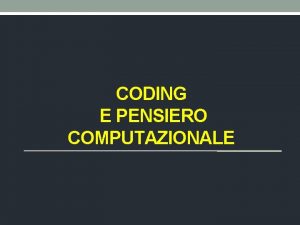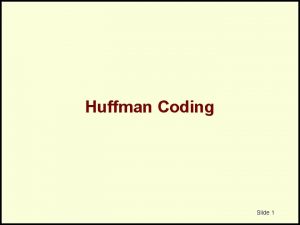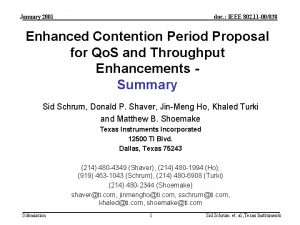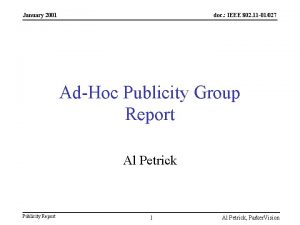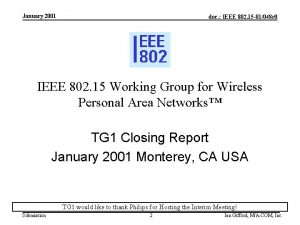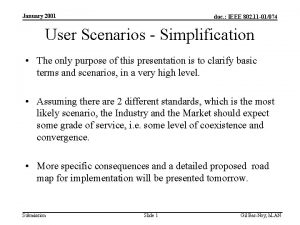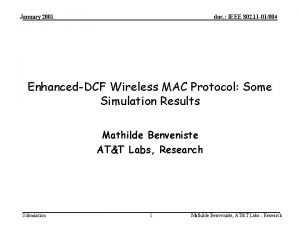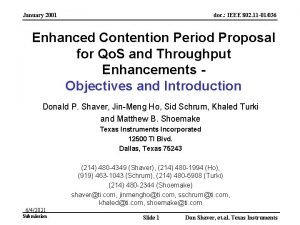January 2001 doc IEEE 802 11 01060 Coding






















- Slides: 22

January 2001 doc. : IEEE 802. 11 -01/060 Coding and Equalization for High Rate Extensions Steve Halford, Ph. D. Mark Webster Paul Chiuchiolo Intersil Corporation Palm Bay, FL Submission 1 S. Halford, M. Webster, P. Chiuchiolo, Intersil Corp.

January 2001 doc. : IEEE 802. 11 -01/060 Performance & Complexity • W-LAN performance is dominated by multipath – Power consumption dominated by receiver complexity – W-LAN systems spend 90% of time in receive mode • OFDM is designed for both AWGN and multipath – Error correcting code for AWGN – Use guard interval to absorb ISI – Use FFT/IFFT and block structure to simplify receive equalizer • PBCC is optimized for AWGN – Error correcting for AWGN OFDM is lesscode complex for W-LAN – Multipath performance depends entirely on receiver Submission 2 S. Halford, M. Webster, P. Chiuchiolo, Intersil Corp.

January 2001 doc. : IEEE 802. 11 -01/060 PER fo 11 Mbps Multipath with No Equalizer • CCK outperforms PBCC-11 • PBCC requires equalizer • Scramble code does not help multipath ? CMF Receiver w/o Equalization Exponential Fading channel with 1 sample/chip Submission 3 S. Halford, M. Webster, P. Chiuchiolo, Intersil Corp.

January 2001 Equalizers Types doc. : IEEE 802. 11 -01/060 • Linear Equalizer: – Linear filter that inverts the multipath channel – Length of filter depends on number of significant multipath rays • Decision Feedback Equalizer (DFE) – Subtracts interference from past data symbols • Uses hard decisions on received symbols prior to error correction – Uses linear equalizer subsection for pre-cursor taps – Can have reasonable complexity and performance for high SNR cases • Viterbi Equalizer (Maximum likelihood sequence estimate or MLSE) – Optimum equalizer (minimizes the bit error rate) – Finds the most likely sequence of transmitted symbol based Submission 4 S. Halford, M. Webster, P. Chiuchiolo, Intersil Corp. on channel

January 2001 doc. : IEEE 802. 11 -01/060 Linear Equalizer: Complexity for W- LANs • Linear Equalizer complexity is driven by length • Simulations indicate a 15 -20 tap equalizer is req’d • Equalizer taps are typically found by matrix inverse proportional to length of filter • Very high complexity -- once per packet • Adaptive estimation can reduce complexity in theory • Convergence is too slow for Wireless LAN systems • Each symbol also requires L complex multiplies & L-1 Linear Equalizers arecomplex too complexadds for adequate performance Submission 5 S. Halford, M. Webster, P. Chiuchiolo, Intersil Corp.

January 2001 doc. : IEEE 802. 11 -01/060 Linear Equalizer vs. OFDM: Receiver Complexity IFFT/FFT for OFDM Equalization • 64 point FFT using radix-4 requires 96 complex multiplies • For each symbol, must perform an FFT at receiver • After receiver FFT, equalizer then requires 52 complex multiplies (1 per tone) • Perform once every symbol -- 80*(1/20 x 106) = 4 x 10 -6 seconds • Equivalent to (4 x (96 + 52))/(4 x 10 -6 ) = 148 x 106 real multiplies per second Single Carrier Linear Equalizer Complexity • Linear Equalizer of length L requires L complex multiplies per symbol • Number of real multiplies = (4*L*11 x 106 ) = L * (44 x 106 ) • Length L must be less than (148/44) = 3. 4 to match complexity of IFFT/ FFT combinations • Using pulse shaping makes this worse due to presence of matched filter! • Not required for OFDM • Doesn’t include the complexity of estimating the equalizer taps • Matrix inverse proportional to L OFDM use of FFT make it less complex than Linear Eq. ** Based on R. Van Nee & R. Prasad, OFDM for Wireless Multimedia Communications, Artech House Publishers, Boston, MA, 2000. Submission 6 S. Halford, M. Webster, P. Chiuchiolo, Intersil Corp.

January 2001 doc. : IEEE 802. 11 -01/060 Decision Feedback Equalizers Equalized Symbols Received Data DFE Whitened Matched Filter Removes ISI from channel precursor + Symbol Slicer (Hard decisions) Channel Post-cursor Filter • Uses WMF and symbol decision feedback to remove ISI – Post cursor filter is only as long as channel • Unlike linear equalizer which is 4 -10 times longer than channel • Does not require a matrix inverse to compute! – Whitened Matched Filter length depends on pre-cursor Submission 7 S. Halford, M. Webster, P. Chiuchiolo, Intersil Corp. and pulse shaping

January 2001 doc. : IEEE 802. 11 -01/060 Decision Feedback Equalizers: Performance • DFE performs well when: – High SNR since symbol decision must be correct • Incorrect decision lead to burst of equalizer generated noise • This will limit range of W-LAN more than AWGN performance – Post-cursor filter is sufficiently long • Possible to use decisions after error correction – Would allow operation at lower SNR won’t work due todelay high SNR complexity of WMF –DFE Long processing and&very high complexity Submission 8 S. Halford, M. Webster, P. Chiuchiolo, Intersil Corp.

January 2001 doc. : IEEE 802. 11 -01/060 MLSE/Viterbi Equalizer Received Data Whitened Matched Filter Viterbi Equalizer Equalized Symbols MLSE • Equalizer estimates the most likely sequence based on knowledge of the channel and the received data – Optimum bit error rate performance – No matrix inverse required – Only need to estimate channel • Equalization is similar to decoding a convolutional code – Searches a trellis of possible paths to find the most likely • For adequate performance, MLSE is the most likely equalizer for PBCC-11, PBCC-22, and higher – Need to track 4 or more paths for adequate performance 9 S. Halford, M. Webster, P. Chiuchiolo, Intersil Corp. Submission

January 2001 doc. : IEEE 802. 11 -01/060 MLSE: Complexity Considerations • Complexity is similar to convolutional decoder • Number of states depends on constellation size and number of multipath rays being tracked Number of States in MLSE ** Example Track 4 rays for 8 -level PSK (PBCC-22) Number of states = 83 = 512 states Eight times as complex as the 64 state PBCC 11/OFDM decoder& only 4 rays are being tracked! ** See pg. 590, J. G. Proakis, Digital Communication, 3 rd Ed. , Mc. Graw-Hill, 1995. Submission 10 S. Halford, M. Webster, P. Chiuchiolo, Intersil Corp.

January 2001 doc. : IEEE 802. 11 -01/060 OFDM is nearly MLSE • OFDM uses a guard interval to absorb multipath interference • Outside the guard interval, signal is multipath free – Multipath causes individual tones to fade • After FFT, each tone is multipath free – Relative fade is known from channel estimation • Viterbi Decoder of error correction code gives MLSE in multipath – Reliability of each soft-decision is weighted by known fade – Optimum receiver is realized with only a FFT – True provided multipath is entirely inside guard interval • Path delay less than 800 n. Secs Submission 11 S. Halford, M. Webster, P. Chiuchiolo, Intersil Corp.

January 2001 doc. : IEEE 802. 11 -01/060 OFDM Multipath Tolerance • OFDM proposal includes 800 n. Secs Guard Interval • Equivalent to 800 e-9 x 11 e 6 = 8. 8 paths at PBCC symbol rate • Multipath tolerance equivalent to tracking 8 paths • FFT complexity is approximately half the complexity of a 64 state decoder Equivalent SC MLSE Complexity This is 8192 times the complexity of the 256 state decoder! Submission 12 S. Halford, M. Webster, P. Chiuchiolo, Intersil Corp.

January 2001 doc. : IEEE 802. 11 -01/060 Convolutional Coding & Complexity • Encoding process is relatively low complexity – Consists of shift registers and combiners • Decoding complexity depends on code properties – Decoders are based on Viterbi algorithm • Viterbi algorithm finds best path into each possible state – Complexity depends on the number of states in decoder • Number of states determines size of the trellis searched by VA • PBCC-11 & OFDM use a 64 -state decoder • PBCC-22 uses a 256 -state decoder – Trellis size (& complexity) is 4 x the equivalent OFDM decoder OFDM has a less complex error correction code Submission 13 S. Halford, M. Webster, P. Chiuchiolo, Intersil Corp.

January 2001 doc. : IEEE 802. 11 -01/060 256 state code vs. 64 state code 0. 8 d. B Advantage for PBCC-22 at 1% PER 1. 0 d. B Advantage for PBCC-22 at 10% PER 0. 8 -1. 0 d. B Coding Gain with 4 x Decoder Complexity Is 1 d. B worth the increased complexity? Submission 14 S. Halford, M. Webster, P. Chiuchiolo, Intersil Corp.

January 2001 doc. : IEEE 802. 11 -01/060 Scramble Code • PBCC-11 & PBCC-22 include a scramble code – Changes the constellation mapping on a per symbol basis • Purpose has never been demonstrated Doesn’t change AWGN performance Submission Doesn’t change multipath performance 15 S. Halford, M. Webster, P. Chiuchiolo, Intersil Corp.

January 2001 doc. : IEEE 802. 11 -01/060 Scramble Code with Equalizer • Does the scramble code help when used with an equalizer? Submission 16 S. Halford, M. Webster, P. Chiuchiolo, Intersil Corp.

January 2001 doc. : IEEE 802. 11 -01/060 Interleavers for W-LAN • Burst Errors will occur in a W-LAN environment – Microwave ovens, photocopiers, & Blue. Tooth will generate bursts of interference – Duration typically 220 n. Secs (photocopier) & 16 ms for microwave***1 • Burst Errors also occur due to MLSE equalizer – Duration depends on # of paths & channel distance • Error burst can overwhelm an FEC code***2 – Interleaver necessary when bursts duration is > 2 symbols – OFDM includes an interleaver to help mitigate PBCC-11 & PBCC-22 need an interleaver! *** 1 K. Blackard, T. Rappaport, & C. Bostian, “Measurements and Models of Radio Frequency Impulsive Noise for Indoor Wireless Communications, ” IEEE Journal on Selected Areas in Communications, Vol. 11, No. 7, pg. 991 -1001, September 1993. ***2 See page 366 of G. C. Clark and J. B. Cain, Error-Correction Codeing for Digital Communications, Plenum Press, New York, NY, 1981. Submission 17 S. Halford, M. Webster, P. Chiuchiolo, Intersil Corp.

January 2001 doc. : IEEE 802. 11 -01/060 Approaches to Higher Data Rates • OFDM provides a known, defined path to achieving higher rates • Higher data rates can be achieved by: – Increasing the constellation size and/or decrease code rate • Used by OFDM to give rates of 6 Mbps to 54 Mbps • PBCC-22 uses 8 -psk with rate 2/3 code to go from 11 Mbps (QPSK with rate 1/2) to 22 Mbps – Increasing symbol rate • PBCC-33 uses 1. 5 times higher clock speed to go from 22 Mbps to 33 Mbps • Increasing the data rate increases the required SNR for AWGN channels – More sensitive to implementation & tracking What is the impact on the equalizer performance and complexity of higher rates? Submission 18 S. Halford, M. Webster, P. Chiuchiolo, Intersil Corp.

January 2001 doc. : IEEE 802. 11 -01/060 Higher Data Rates: Equalizer Complexity • OFDM Equalizer has fixed complexity for all proposed rates – Higher rates does impact performance due to fading of tones • Guard interval however reduces the impact independent of rate • MLSE complexity will grow exponentially when constellation size increases – Higher rates will impact performance • No guard interval to protect from increased ISI sensitivity – Example: Track 4 paths -- Number of states = (constellation size)4 -1 • 22 Mbps (8 -PSK) requires 83 = 512 states (8 x the PBCC-11 decoder) • 33 Mbps (16 -QAM) will require 163 = 4096 states (64 x the PBCC-11 decoder) 3 = 262144 states (4096 x the • 44 Mbps (64 -QAM) will require 64 Extending PBCC to higher rates by increasing constellation PBCC-11 decoder) is not practical Submission 19 S. Halford, M. Webster, P. Chiuchiolo, Intersil Corp.

January 2001 doc. : IEEE 802. 11 -01/060 Higher Data Rates: Equalizer Complexity • OFDM uses a fixed symbol rate for all data rates – Guard interval protection is same for all rates • PBCC-33 is PBCC-22 at a higher symbol rate – Pulse shaping used to keep same spectral width • Increasing symbol rate impacts performance – Increasing timing accuracy requirements • Increasing rate increase number of equalizer paths – Example: 8 -PSK -- Number of states = 8(number of paths -1) • 22 Mbps (11 Mhz, 4 paths) -- 84 -1 = 512 states (8 x the PBCC-11 decoder) • 33 Mbps (16. 5 Mhz, 6 paths) -- 86 -1 = 32, 768 states (512 x PBCC-11 decoder) • 44 Mbps (22 Mhz, 8 paths) -- 88 -1 = 2, 097, 152 states (32, 768 x PBCC-11 decoder) Extending PBCC to higher rates by increasing symbol rate is not practical Submission 20 S. Halford, M. Webster, P. Chiuchiolo, Intersil Corp.

January 2001 Conclusions doc. : IEEE 802. 11 -01/060 • Equalization is required for W-LAN systems – Receiver complexity is critical to successful systems • Linear and DFE equalizers are not practical for proposed high rate single carrier systems • MLSE is only viable equalizer for proposed systems – Complexity can grow exponentially • PBCC-22 FEC is 4 x as complex as industry standard – Yields less than 1 d. B improvement • PBCC-22 inherited the scramble code – Appears to be un-necessary • PBCC-22 lacks an interleaver – Poor performance with burst errors Submission 21 S. Halford, M. Webster, P. Chiuchiolo, Intersil Corp.

January 2001 Conclusions doc. : IEEE 802. 11 -01/060 • OFDM provides near to MLSE performance – Guard interval absorbs multipath – Complexity is small fraction of MLSE for PBCC – Complexity remains fixed for proposed data rates! • OFDM uses industry standard FEC code • OFDM includes an interleaver • OFDM is less complex than PBCC for W-LAN – No hidden complexity details • OFDM gives access to higher than 22 Mbps rates – PBCC complexity grows exponentially Submission 22 S. Halford, M. Webster, P. Chiuchiolo, Intersil Corp.
 Open coding axial coding selective coding adalah
Open coding axial coding selective coding adalah Open coding adalah
Open coding adalah Bridges from 802.x to 802.y
Bridges from 802.x to 802.y Bridges from 802.x to 802.y
Bridges from 802.x to 802.y Ieee 802 family
Ieee 802 family Ieee 802 3 compliance
Ieee 802 3 compliance Wlan standards
Wlan standards Arquitetura ieee 802
Arquitetura ieee 802 Modelo ieee 802
Modelo ieee 802 Ieee 802 standard
Ieee 802 standard 802 15
802 15 802 ieee
802 ieee Ieee 802
Ieee 802 Axial coding vs open coding
Axial coding vs open coding Coding dna and non coding dna
Coding dna and non coding dna 802 protocols
802 protocols 802 11
802 11 Wireless lan 802
Wireless lan 802 Wlan 802
Wlan 802 Ethernet 802
Ethernet 802 802-3-ethernet
802-3-ethernet 802 family
802 family Lan 701
Lan 701















